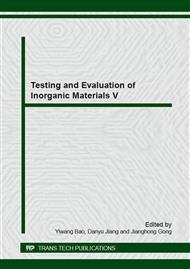[1]
C.R. Lin, C.C. Wang, I.H. Chen, Magnetic behavior of core–shell particles, J. Magn. Magn. Mater. 304 (2006) e34-e36.
Google Scholar
[2]
S. Sun. Recent Advances in Chemical Synthesis, Self-Assembly, and Applications of FePt Nanoparticles, Adv. Mater. 18 (2006) 393-403.
DOI: 10.1002/adma.200501464
Google Scholar
[3]
D.V. Szabό, D. Vollath, Nanocomposites from Coated Nanoparticles, Adv. Mater. 11 (1999) 1313-1316.
Google Scholar
[4]
J. Nogués, J. Sort, V. Langlais, V. Skumryev, S. Suriñach, J.S. Muñoz, M.D. Barό, Exchange bias in nanostructures, Phys. Rep. 422 (2005) 65-117.
DOI: 10.1016/j.physrep.2005.08.004
Google Scholar
[5]
Q.X. Liu, Z.H. Xu, J.A. Finch, R. Egerton, A Novel Two-Step Silica-Coating Process for Engineering Magnetic Nanocomposites, Chem. Mater. 10 (1998) 3936-3940.
DOI: 10.1021/cm980370a
Google Scholar
[6]
J. Crangle, The Magnetic Properties of Solids. Grat Britain, Edward Arnold, (1977).
Google Scholar
[7]
B. Huke, M. Lücke, Magnetic properties of colloidal suspensions of interacting magnetic particles, Rep. Prog. Phys. 67 (2004) 1731-1768.
DOI: 10.1088/0034-4885/67/10/r01
Google Scholar
[8]
M.P. Sharrock, Particulate Magnetic Recording Media: A Review, IEEE. Trans. Magn. 25 (1989) 4374-4389.
DOI: 10.1109/20.45317
Google Scholar
[9]
B.C. Wen, J. Li, Y.Q. Lin, X.D. Liu, J. Fu, H. Miao, Q.M. Zhang, A novel preparation method for γ-Fe2O3 nanoparticles and their characterization, Mater. Chem. Phys. 128 (2011) 35-38.
DOI: 10.1016/j.matchemphys.2011.01.012
Google Scholar
[10]
L.L. Chen, J. Li, Y.Q. Lin, X.D. Liu, L.H. Lin, D.C. Li, Surface modification and characterization of γ-Fe2O3 nanoparticles synthesized by chemically-induced transition, Mater. Chem. Phys. 141 (2013) 828-834.
DOI: 10.1016/j.matchemphys.2013.06.011
Google Scholar
[11]
R. Arulmurugan, G. Vaidyanathan, S. Sendhilnathan, B. Jeyadevan, Co–Zn ferrite nanoparticles for ferrofluid preparation: Study on magnetic properties, Physica. B. 363 (2005) 225-231.
DOI: 10.1016/j.physb.2005.03.025
Google Scholar
[12]
T. Sato, T. Iijima, M. Seki, N. Inagaki, Magnetic properties of ultrafine ferrite particles, J. Magn. Magn. Mater. 65 (1987) 252-256.
DOI: 10.1016/0304-8853(87)90044-8
Google Scholar
[13]
C.P. Bean and J.D. Livingston, Toward a model for Co-surface-treated Fe-oxides, J. Appl. Phys. 30 (1959) 120s-129s.
Google Scholar
[14]
F.E. Luborsky and T.O. Paine, Superparamagnetism, J. Appl. Phys. 31 (1960) 68s-70s.
Google Scholar
[15]
D.F. Eagle and J.C. Mallinson, On the Coercivity of γ-Fe2O3 Particles, J. Appl. Phys. 38 (1967) 995-997.
Google Scholar


